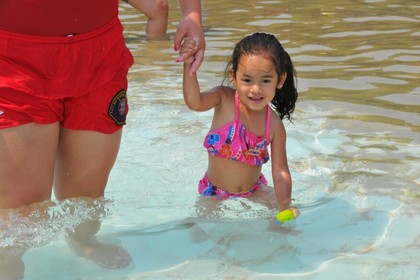Devising Layers of Safety at Aquatics Facilities

Tuesday, May 10, 2022
As summer approaches, it’s good to review your drowning-prevention measures. The four here are just a handful to include in a comprehensive drowning-prevention plan.
A child-supervision policy is a fantastic practice to adopt if you have patrons with infants, toddlers, pre-school and school-age children. A child-supervision policy serves as a mechanism for lifeguards and staff to educate and, if necessary, require guardians to participate as the primary provider in the child’s supervision and well-being. Start with a clearly written, easily visible policy that requires active supervision. Depending on the minor’s age, “active” could mean the child is within arm’s reach of the guardian at all times, that they immediately respond to verbal commands from the guardian, or that, if asked where their guardian is, the child can point to them, and the guardian sees this action and acknowledges that they’re participating in supervision, “Child points to parent, parent waves back to the child and lifeguard.”
Spread the word
Once a child-supervision policy is established, you must make it known to patrons and the community. Make the policy available on websites and voice recordings so patrons find it when they search for your hours of service, recreational swimming and aquatic programming, or information about reservable sites. When at the facility, guardians must see or hear the policy multiple times before they even touch the water. Post it at the entrance and verbalize it as patrons pay to enter. Display the policy in changing areas, on an A-frame on the pool deck and other areas throughout the facility.
With the policy in place, education and enforcement roles must be established between lifeguards and staff. When a lifeguard identifies a child without guardian supervision, they should follow the steps outlined on the decision tree on the following page. The tower lifeguard should follow the algorithm quickly since their primary focus is water surveillance. If the lifeguard can’t resolve the issue after the first contact with the child (5-10 seconds), the situation must be elevated and transferred to a lead staffer so the lifeguard can resume surveillance.
In-service training focused on child supervision and roles should take place as often as for water rescues. Include review of the policy, Q&A with staff, followed with scenarios that involve a variety of ages, activities and programming. Also include multiple children with one guardian, and multiple children with different ages with one guardian.
Training should close with lead staff going through the same scenarios, showing what the interaction would look like between lead staff and parent. Depict different moods of guardians: compliant, resistant, apologetic, lazy, overwhelmed and hostile. It is important that lifeguards witness lead staff training. This crystallizes the entire process: from initial contact with the child to closing the loop with the guardian. Remember: initial contact with the child, and education of the guardian should be tracked as part of your data collection.
Other measures
The use of wristbands, swim tests and life-jacket loaner stations will strengthen your child supervision policy and drowning-prevention program.
Wristbands can identify non-swimmers, camp groups, program participants, those who need guardian supervision, and who passed the swim test. They can be customized to say, “Guardians, please watch your children.” They provide a means to collect data and track prevention measures.
Patrons should test every day they want to go into the deep areas or features that require a swim test. Passing on Monday doesn’t mean you can on Friday. This should be part of all your aquatic programming: recreational swimming, junior lifeguards, day camps and aquatic events that require swimming proficiency. In-service should cover the swim-test policy and scenarios showing how to talk with children and parents about passing and not passing the test. This also can be tracked.
Life-jacket loaner stations can help non-swimmers who cannot successfully pass the swim test or who need additional support. When discussing life jackets with patrons, describe them as personal protective equipment equivalent to a bike helmet, safety glasses or steel-toed boots. They are used for boating, fishing, rafting, SUP, kayaking and all aquatics activities, by non-swimmers as well as highly proficient swimmers and even professionals. Practice proper sizing and fitting of a life jacket on a variety of body shapes and sizes of people, and make sure these talking points are memorized in your in-service. This measure also can be tracked.
Use your data to paint a detailed picture of how your aquatics department safeguards the community. Revenue, attendance, rescues, first aids, swim lessons given, and number of day camp participants don’t tell an accurate picture alone.